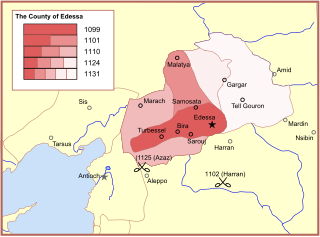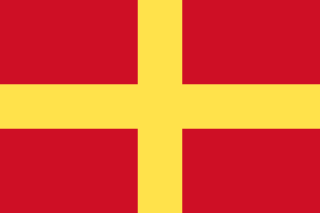
Baldwin I, also known as Baldwin of Boulogne, was the first count of Edessa from 1098 to 1100, and king of Jerusalem from 1100 to his death in 1118. He was the youngest son of Eustace II, Count of Boulogne, and Ida of Lorraine and married a Norman noblewoman, Godehilde of Tosny. He received the County of Verdun in 1096, but he soon joined the crusader army of his brother Godfrey of Bouillon and became one of the most successful commanders of the First Crusade.

Baldwin II, also known as Baldwin of Bourcq or Bourg, was Count of Edessa from 1100 to 1118, and King of Jerusalem from 1118 until his death. He accompanied his cousins Godfrey of Bouillon and Baldwin of Boulogne to the Holy Land during the First Crusade. He succeeded Baldwin of Boulogne as the second count of Edessa when he left the county for Jerusalem following his brother's death. He was captured at the Battle of Harran in 1104. He was held first by Sökmen of Mardin, then by Jikirmish of Mosul, and finally by Jawali Saqawa. During his captivity, Tancred, the Crusader ruler of the Principality of Antioch, and Tancred's cousin, Richard of Salerno, governed Edessa as Baldwin's regents.

The County of Edessa was a 12th-century Crusader state in Upper Mesopotamia. Its seat was the city of Edessa.

The Principality of Antioch was one of the crusader states created during the First Crusade which included parts of modern-day Turkey and Syria. The principality was much smaller than the County of Edessa or the Kingdom of Jerusalem. It extended around the northeastern edge of the Mediterranean, bordering the County of Tripoli to the south, Edessa to the east, and the Byzantine Empire or the Kingdom of Armenia to the northwest, depending on the date.

The County of Tripoli (1102–1289) was the last of the Crusader states. It was founded in the Levant in the modern-day region of Tripoli, northern Lebanon and parts of western Syria. When the Frankish Crusaders – mostly southern French forces – captured the region in 1109, Bertrand of Toulouse became the first count of Tripoli as a vassal of King Baldwin I of Jerusalem. From that time, the rule of the county was decided not strictly by inheritance but by factors such as military force, favour and negotiation. In 1289 the County of Tripoli fell to Sultan Qalawun of the Muslim Mamluks of Cairo. The county was absorbed into Mamluk Egypt.

Leo I, also Levon I or Leon I, was the fifth lord of Armenian Cilicia (1129/1130-1137).

The Crusader state of the Kingdom of Jerusalem, created in 1099, was divided into a number of smaller seigneuries. According to the 13th-century jurist John of Ibelin, the four highest crown vassals in the kingdom proper were the count of Jaffa and Ascalon, the prince of Galilee, the lord of Sidon, and the lord of Oultrejordain.

There were six major officers of the kingdom of Jerusalem: the constable, the marshal, the seneschal, the chamberlain, the butler and the chancellor. At certain times there were also bailiffs, viscounts and castellans.

Agnes of Courtenay was a Frankish noblewoman from the Crusader states. Agnes's parents, Joscelin II of Edessa and Beatrice of Saone, lost the County of Edessa in 1150. As the widow of Reynald of Marash, Agnes married Count Amalric of Jaffa and Ascalon, younger son of Queen Melisende. When he unexpectedly inherited the crown in 1163, the High Court of Jerusalem refused to accept Agnes as queen and insisted that Amalric repudiate her in return for their recognition of his succession. Agnes retained the title of countess and married twice more. She gained influence after Amalric died and their son, Baldwin IV, became king.
The Lordship of Ramla was one of the Crusader vassal states of the Latin Kingdom of Jerusalem. It has been vassal to and part of the County of Jaffa and Ascalon.
The Principality of Antioch mirrored the Latin Kingdom of Jerusalem in its selection of great offices: constable, marshal, seneschal, admiral, Chamberlain, butler, chancellor and at certain times also bailiff.
The Kingdom of Cyprus, as an offshoot of the Kingdom of Jerusalem, maintained many of the same offices, such as: seneschal, constable, marshal, admiral, Chamberlain, and chancellor.
Gabriel of Melitene was an Armenian general and the ruler of Melitene.
Philippa was suo jure Countess of Toulouse, as well as the Duchess of Aquitaine by marriage to Duke William IX of Aquitaine.
William of Bures was Prince of Galilee from 1119 or 1120 to his death. He was descended from a French noble family which held estates near Paris. William and his brother, Godfrey, were listed among the chief vassals of Joscelin of Courtenay, Prince of Galilee, when their presence in the Holy Land was first recorded in 1115. After Joscelin received the County of Edessa from Baldwin II of Jerusalem in 1119, the king granted the Principality of Galilee to William. He succeeded Eustace Grenier as constable and bailiff in 1123. In his latter capacity, he administered the kingdom during the Baldwin II's captivity for more than a year, but his authority was limited.
Baldwin of Marash was a Crusader baron in northern Syria, the lord of Marash from at least 1136.
The siege of Edessa in October–November 1146 marked the permanent end of the rule of the Frankish Counts of Edessa in the city on the eve of the Second Crusade. It was the second siege the city had suffered in as many years, the first siege of Edessa having ended in December 1144. In 1146, Joscelyn II of Edessa and Baldwin of Marash recaptured the city by stealth but could not take or even properly besiege the citadel. After a brief counter-siege, Zangid governor Nūr al-Dīn took the city. The population was massacred and the walls razed. This victory was pivotal in the rise of Nūr al-Dīn and the decline of the Christian city of Edessa.
Basil the Doctor was an Armenian priest and poet. As the chaplain and confessor of Baldwin, Frankish lord of Marash, he wrote a funeral oration on the latter's death at the battle for Edessa in 1146.
The Marash earthquake occurred in the area of Marash during the early morning hours of November 29, 1114.
The Lordship of Marash was a territorial lordship in northeastern Cilicia between 1104 and 1149, centred on the city of Marash. One of the lesser Crusader states, it played a major role in the defence of the northern frontier in the 1130s and 1140s under Lords Geoffrey and Baldwin. Its position became untenable after the fall of Edessa in 1146.